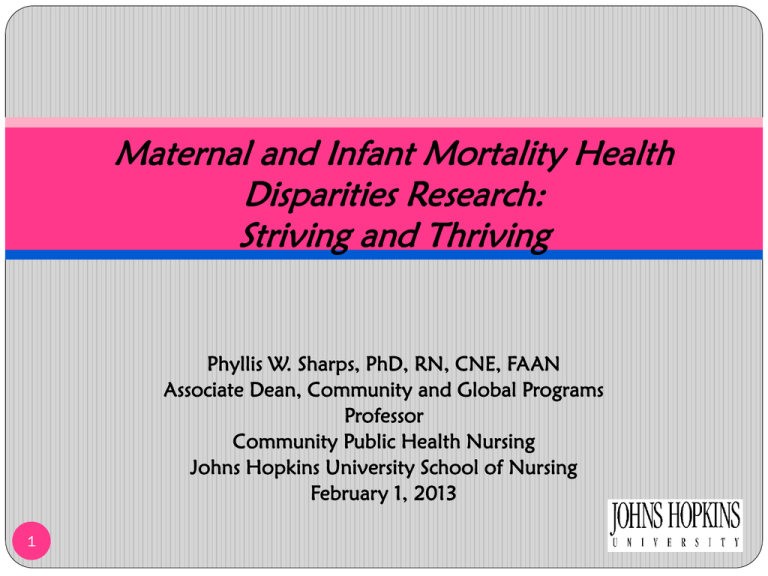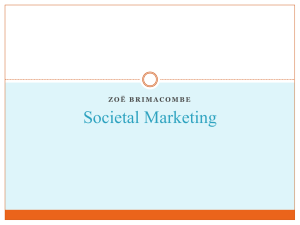
Maternal and Infant Mortality Health
Disparities Research:
Striving and Thriving
Phyllis W. Sharps, PhD, RN, CNE, FAAN
Associate Dean, Community and Global Programs
Professor
Community Public Health Nursing
Johns Hopkins University School of Nursing
February 1, 2013
1
Perinatal Nurse Home Visitation Home
Visitation Enhanced with mHealth
(DOVE 2)
NIH/NINR - R01NR009093-01A2 /NINR
2
The Journal Begins With A Vision:
Excellence in Nursing
3
MARY SEACOLE
1805 - 1881
Mary Seacole's reputation after the Crimean
War (1853-1856)rivaled Florence
Nightingale's. Unlike Nightingale, Seacole also
had the challenge to have her skills put to
proper use in spite of her being black. A born
healer and a woman of driving energy, she
overcame official indifference and prejudice.
She got herself out to the war by her own
efforts and at her own expense; risked her life
to bring comfort to the wounded and dying
soldiers; and became the first black woman to
make her mark on British public life. But while
Florence Nightingale has gone down in
history and become a legend, Mary Seacole
was relegated to obscurity until recently.
4
Hatching DOVE
Active duty – military perinatal nurse
Maternal and Infant Clinical Nurse Specialist
Home Visiting – Reaching Mothers and Infants
Parents and Children Together – HOME (doctoral
student)
Adolescent Postpartum Depression and Mother and
Infant Interaction (dissertation research)
Pride in Parenting (lay home visitors; DC Cooperative
Perinatal Studies to Reduce IMR)
Passport to Health (nurse home visit intervention to
reduce violence related health disparities)
5
Hatching DOVE
Other Constant Research and Practice
Interests:
Reducing Infant Mortality Rate among
African American women
Depressive symptoms in pregnant and
parenting low income women
IPV and perinatal health outcomes
6
Hatching DOVE
Other Experiences
Research assistant
Member of interdisciplinary research team
Mentored research with a senior research (K Award)
Working and listening to community - shelter
Immersing in research activities/environment
(NNVAWI/Research Consortium)
7
All contributed to my keen desire to do health
disparities research – before it was even called
health disparities
Background for DOVE
IPV violence during pregnancy linked with adverse
outcomes for:
Mothers
Infants
More than 3 million children witness IPV of
mother each year
More than 50% of these children are under 6
years old
8
Background for DOVE
8-22% of pregnant women (vs. 7%
pre-eclampsia or hypertension
during pregnancy)
Most significant risk factor - abuse
before pregnancy.
9
Background for DOVE
(Ballard et. al., ’98)
Protective period
Women beaten before and after – (30%)
Risk period
May start during pregnancy (24%) –
especially first pregnancy “Business as usual”
IPV neither increases or decreases (75%) (Martin ’01; Saltzman ‘03)
10
Background for DOVE
Patterns of IPV During Pregnancy
Type of Abuse Changes
Physical abuse may lessen or stop but emotional abuse,
controlling behaviors stay same or increase (Castro ’03)
Teens at Greater Risk
Higher prevalence of abuse during pregnancy among
adolescents than adult women (Parker, McFarlane ’93)
11
Background for DOVE
Ethnic group comparison
significantly lower in Hispanic
couples (Mexican American) -14%
vs. 16% in African American and
Anglo (McFarlane & Parker ‘92)
12
Abuse During Pregnancy By Ethnic Group And
Assessment (N=1000)
*Torres, Campbell, et.al. ‘99
Birth weight & Abuse During
Pregnancy (NINR)
9
8
7
AAS
ISA-P
6
5
4
3
2
N=187
N=198
N=89
N=141
Puerto
Rican
Mexican
American
Cuban
American
Central
American
Anglo
0
African
American
1
N=192
N=196
13
Background for DOVE
Associated with poor outcomes
Late entry into prenatal care
Increased low birth weight birth
Poor weight gain
Increased preterm delivery
Poor adherence to medications
14
Background for DOVE
IPV Correlates
Depression
Substance abuse
Low social
support
IPV Correlates
Spontaneous
abortion
Smoking
Risk of homicide
(Gielen et al ‘94; Campbell et al ‘92)
15
Background for DOVE
Infant Health Correlates
LBW
Low income/poor women
(Bullock & McFarlane ‘89)
Connections w/ smoking
Poor maternal low weight gain
substance abuse (Curry et al ‘99)
Child Abuse
Most severe abuse – non-biological father
16
Background for DOVE
(Campbell et al ‘99;Torres et al ’01)
Poor Infant Outcomes
LBW in term infants
Evidence of mediation in multivariate LR
17
Physical abuse - risk factor (OR = 3.29)
Physical abuse not a risk factor for preterm-infants
(bivariate analysis)
Low weight gain (OR = 3.4)
And/or inadequate prenatal care (OR = 1.8)
And/or poor obstetric Hx (OR = 3.6)
Infant Mortality Rates
(CDC
2012)
14
12
10
8
Series 1
Column1
Column2
6
4
2
0
National
18
Whites
Blacks
Hispanics
Infant Mortality
Miami-Dade County
Infant mortality rates most profound
indicator of health disparities
Blacks have the highest rate 2.5 times
higher than Whites and 3 times higher
than Hispanics
19
Background for DOVE
IPV AND Maternal Mortality
Maternal Mortality
Death from all causes during pregnancy, and year after
delivery or pregnancy termination
Homicide
Leading cause of maternal mortality in US cities where
measured (NYC, Chicago, DC) (Dannenberg, ’95; Krulewitch ‘01)
Leading cause of maternal mortality in entire state of MD - –
20% of deaths (Horon & Cheng, 2001)
20
Background for DOVE
21
Little evidence of
appropriate
interventions to reduce
IPV among mothers and
exposure for neonates
and infants
DOVE proposes to
address this gap
Domestic Violence Enhanced Home
Visitation Program
(DOVE)
NIH/NINR - R01 NR009093
22
Purpose of DOVE
Rigorous test of structured IPV intervention –
DOmestic Violence Enhanced Home Visitation
Program
Mothers and infants
2 Sites and Settings
Urban – Baltimore City HD
Urban – Missouri HD
Rural – Missouri HD
23
Design
3 different designs in 3 different settings
RCT
Mixed methods – quantitative & qualitative
BCHD (women and infants)
Eligible women = R→ DOVE vs. UC
MOHD (women and infants)
12 HDs = R→ 6 HD DOVE vs. 6 UC
NFP (Olds HV model; mothers and infants)
DOVE vs. Olds database
24
Schema for DOVE Project
URBAN (Baltimore City Health Dept.)
RURAL (Missouri Health Dept.)
12 HD’s (N=160)
1 NFP (N=40)
RANDOMIZE
REFERRAL
Referrals
BCHD
RANDOMIZE
Usual Care
(M&I)
Usual
Care
(6 HD’s)
DOVE
(6 HD’s)
DOVE
(M&I & DOVE)
Data Collection/Follow Up Assessments
25
Kansas City, Missouri
DOVE-NFP
Selected from
NFP
National Data
Methods
Recruit women – up to 31 weeks gestation
Intervention
DOVE = Structured IPV pamphlet
Nurse home visit intervention + DOVE
DOVE – 3 prenatal sessions
DOVE – 3 postpartum sessions (up to 12 weeks)
Data Collections
Baseline (recruitment)
Delivery
Postpartum – 3, 6,12,18, 24 months
26
Methods
Quantitative Study: Measures
IPV
Maternal Mental Health ( stress,
depression, PTSD)
Parenting (stress, stimulation)
Infant Growth & Development
Use of Community Resources
27
Methods
Qualitative Study
Patterns of IPV
Urban/Rural influences on
patterns of IPV
28
DOVE Has Wings
Funded – Feb 1, 2006 – Nov 30, 2011
Human Subjects Approvals
2 Universities and 2 Health Departments
Certificate of Confidentiality
- Final IRB Approvals
- Data Collection
- Began – Dec, 2006
- Ended – October 2011
29
DOVE Project Team
Investigators
Phyllis Sharps, PhD, RN, PI - JHUSON
Linda Bullock, PhD, RN, Co-PI – Univ. of
Missouri
Jackie Campbell, PhD, RN, Co-PI JHUSON
Linda Rose, PhD, RN , Investigator JHUSON
Michelle Cooley, PhD, Investigator JHBSPH (child psychologist)
Consultants
30
David Olds, PhD – Univ. of Colo. (NFP)
Barbara Parker, PhD, RN, UVA (Structured
Intervention)
Linda Pugh, PhD, RN – York College
(intervention fidelity monitoring)
Karen Soeken, PhD – Professor Emeritus
(biostatistician)
Sharon Ghazarian, PhD (biostatistician) )
PROJECT STAFF
Project Coordinator
Kim Hill, MPH
DOVE Intervention Nurse
BCHD –Keauna Williams, BSN
DOVE Research Nurses
Etasha Crowder, BSN
Kristina Marcantonio, MSN
Post Doctoral Fellow
Sandra Giangrande, PhD, RN
Doctoral Students
Jeanne Alhusen, PhD, RN
Marguerite Baty, PhD, RN
Rachel Walker, UG Honors
Research – now PhD candidate
Are We Making A Difference
Preliminary Findings
31
Baseline Demographics
Demographic
Characteristics
Mean Age
Racial Background:
African American
White
Other
Education:
Less Than High School
HS/GED
Some College/Trade
Trade/Community
College/College Grad
Marital Status:
Single
Partnered/Not Married
Married
Divorced
Other
Employment Status:
Employed FT
Employed PT
32 Unemployed
Total
Sample
N= 238
DOVE
Sample
N= 124 (52%)
Usual Care
Sample
N= 114 (48%)
24
24
23
47%
42%
11%
44%
45%
11%
51%
40%
9%
41%
25%
23%
11%
40%
26%
24%
9%
40%
24%
22%
14%
51%
--%
25%
11%
6%
52%
24%
15%
2%
8%
49%
26%
8%
11%
6%
12%
16%
72%
12%
11%
76%
12%
21%
67%
Preliminary Data:
IPV and Health Outcomes
Mean Scores
Health Indicator
33
Black American
White American
Other
Conflict Tactics Scale
(IPV)
73
71
56
Edinburgh Depression
Scale (Depression)
16
13
8
Davidson Trauma Scale
(PTSD)
64
33
18
Severity of Violence
Against Women Scales
85
92
87
Women’s Experience
With Battering
33
30
37
Other Preliminary Findings
Nurse HV for abuse women feasible
DOVE can be integrated into HD HV
programs
Good retention
DOVE reduced self reported IPV
UC reduced IPV too
More analysis
Multiple partners
Did DOVE work better for some women
SGA babies and IPV
34
Other “ANNA” Stories
Data analyses from the Qualitative Phase of
the DOVE study are showing that women,
whose violence was addressed early during the
home visiting program, are telling us about
many positive choices they are making in
improving their lives and their children’s lives
by 24 months post-delivery.
Talking about the violence to the home visitor
has been powerful!
Women will talk about IPV
35
Lessons Learned
Developing Partnerships
36
Academic-Community Partnership
Johns Hopkins School of Nursing (JHUSON)
Location: Baltimore, Maryland, USA
Mission: To provide leadership to improve health
care and advance the profession through education,
research, practice, and service.
Baltimore City Health Department (BCHD)
Location: Baltimore, Maryland, USA
Mission: Maternal and Infant (M&I) Nursing
Program provides home visiting and case
management services to pregnant women and
infants in Baltimore City in order to improve
maternal health, birth and infant outcomes.
37
Partnership Benefits
Established Infrastructures
JHUSON Academic Resources
BCHD-M&I Program Community Resources
Sharing of Resources
DOVE Intervention Nurse=Liaison
Between JHUSON & BCHD-M&I
Implementation of DOVE intervention into existing BCHD-
M&I program
Application of evidenced based research into real practice
setting – a test of efficacy
Potential Positive Impact on MCH Outcomes
38
Preparing to Launch DOVE
Developing The Town (Home Visitors) and Gown
(Research team) Partnership
Both Health Departments:
The Missouri Department of Health and Senior Services
(MoDHSS)
Baltimore City Health Department Maternal and Infant
Home Visit programs
Extremely supportive of identifying IPV and working
with both research teams
39
Developing the Town/Gown Partnership
Examples of activities to develop partnership
Research team members made frequent visits to the DOVE sites
and reviews the research protocol with trained HV and new staff
Monthly meeting with BCHD to discuss DOVE protocols
DOVE Nest newsletter sent monthly to all health departments
Conducted professional in service training for health departments
We have conducted 10 different workshops regarding screening
for IPV with the home visitors over a four -year period at both
sites
40
Issues for the Partnership
Challenges of partnering with urban and rural health
departments
Home Visitors lack of educational preparation regarding
41
research protocols
Lack of understanding of the importance of screening for
IPV
Discomfort with screening for IPV
Rural Settings - distance that has to be traveled by the
research team to maintain relationships with the staff
Urban Settings – bureaucratic procedures that hinder
recruitment process
Urban Settings – large case loads limit time available for
intervening
Threat To The Study’s Integrity
After 3 ½ years of recruitment – referrals made at
both sites (Baltimore and MO) have not met
targeted goals
PIs at both sites hypothesized that:
There may be an issue with women disclosing:
Because of the rural setting of the MO site
Because of the urban setting of Baltimore site
The HVs are not comfortable screening women for
IPV
Barriers Study
42
Partnership Limitations
Control
Interdependence of each entity for project results
Communication
Ensuring all team members are up-to-date
Motivation
43
Team members professional investment in project
Clinical Significance
DOVE combines
44
evidenced based
protocols
DOVE an be integrated
into existing culturally
based approaches
DOVE intervention is
low cost
DOVE intervention
requires training and
“buy-in”
Women had many
positive comments about
DOVE
Striving and Thriving
Find your passion
Being part of a team or partnership
Nurturing is the norm
Committed to success of all members
Mutual benefits
Expected, spelled out, agreed upon
Establishment of trust
Clear expectations – but some give and take
Meeting deadlines – mutual respect not
obligations
45
Striving and Thriving
Community Connections
Be a part of a community – a real commitment
Community is also a part – a real commitment
Meaningful and important roles and involvement
for community members
Do no harm
Share what you learn with the community
Enhance the community – include on teams
46
Striving and Thriving
Planned Small Steps
Projects
Small projects
Each project builds on the next
Carve out a part of a larger project – that builds on
where you want to go
Funding
Foundations
Professional groups
Community Groups/Faith partners
NIH ( Mentored awards, small R’s →→ RO1)
47
Striving and Thriving
Have Fun Along the Way !!
Celebrate the achievements of all (publications,
presentations, recruitment goals, enrolling in courses)
Celebrate the milestones
Support each other over the rejections and
disappointments
(no funding, rejections, slow recruitment, grants, abstracts, manuscripts,
slow recruitment)
48
NATIONAL DOMESTIC VIOLENCE HOTLINE
1-800-799-SAFE
NURSING NETWORK ON VIOLENCE AGAINST
WOMEN INTERNATIONAL (NNVAWI)
1-888-909-9993
NNVAWI.ORG
NATIONAL DOMESTIC VIOLENCE HEALTH
RESOURCE CENTER (FVPF)
1-800-537-2238
ENDABUSE.ORG
49
DOVE WEBSITE
http://www.son.jhmi.edu/research/dove
psharps@son.jhmi.edu
410-614-5312
Thank You !!!
50







